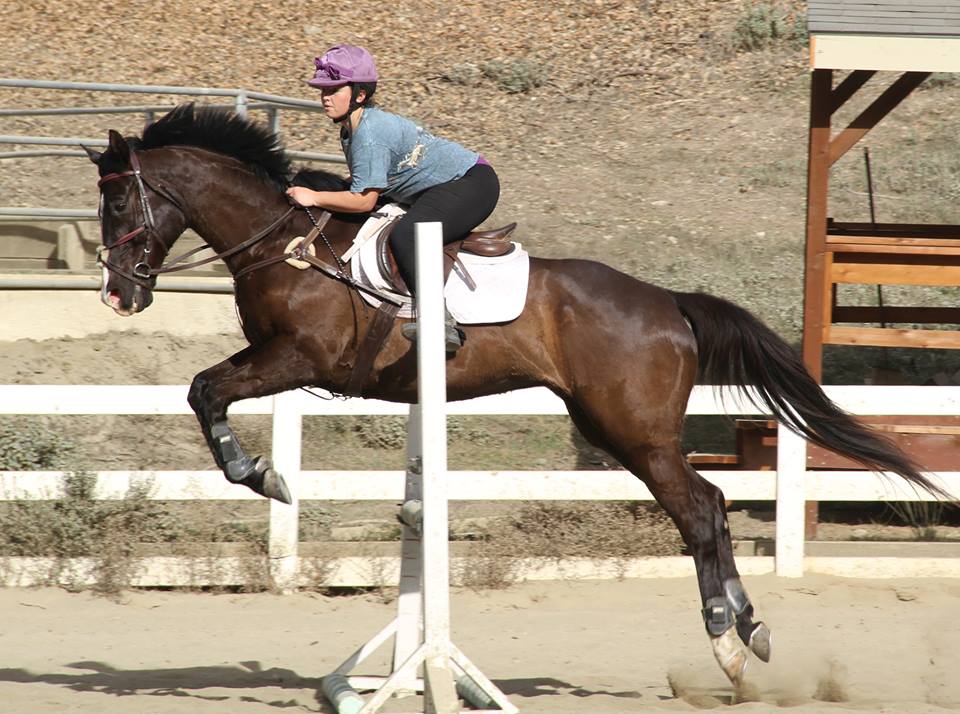Search the Site
Photo # 55: This is Rachel! (Current Freebie!)
My horse tends to drop his knees (like in the attached picture) over fences. He doesn't ALWAYS do this, but I have been finding he has been doing it more frequently. It usually when he chips in and adds a stride, which I'm guessing is due to a canter lacking enough impulsion? I'm having a hard time getting him to have enough forward energy without letting him get fast and flat. Do you have any exercises to work on to help fix this? (Rachel)
Hi Rachel!
Whenever a horse gets underneath a fence, and jumps with low knees - it is almost always a result of the quality of the canter in the approach to the fence. I'm willing to bet that this horse was strung out or flat in his frame on the approach to this jump. And it is likely that this horse had momentum in his canter, rather than true impulsion. Whenever a horse's shoulders and forelegs are pointing downward over a jump, it means the front end was so heavily loaded at the moment of takeoff, that they were unable to rock back sufficiently on their hind legs to lift the front end properly. This is called jumping over the front end.
I would reccommend that you make sure all your jumps have a rolled out ground line for a while. Put the pole out in front of the fence approximately the same as the height of the fence. So if you are jumping 2 feet, roll the ground rail out 2 feet from the base of the jump. And if you are jumping 3 feet high, roll it out about 3 feet. The rolled out ground line prevents the horse from getting underneath the fence, and teaches him how to "pat the ground" rather than get so close that he cannot rock back and lift his shoulders on the takoff. Airy jumps or those without a ground line require a confident, experienced horse that has learned to watch the top rail of his fences. A rolled out ground line will help to keep him from making mistakes while he learns, which will improve his confidence in his ability.
Meanwhile, I would be doing lots of work on maintaining a good quality canter! Read this article on how to package the canter stride when jumping, and this one on the adjustability exercise. Lots of half halts, rein backs, and transitions... particularly those that skip a gait like trot to halt or canter to walk, will help you to coil the spring of your horse's hind legs, to put him in a state of balance where he can be more agile. Also read this article on the Rubber Band exercise, and incorporate transitions within the gaits in your everyday work. The more you put in the homework, the better your results will be. In other words, don't waste any of your schooling time. This type of horse needs tons and tons of transitions per ride. And I am talking about both flatwork and jumping days.
It can be a good idea to try doing some courses at home where you perform a halt and rein back between every single jump on course. Get a good canter, jump the first fence. Halt, rein back (keeping the horse straight), walk forward, smooth transition to canter and jump the next. And so on throughout the course. This disciplined approach will help you to create the habit of getting your horse back on his hocks after each jump, so that he doesn't get rolling more and more on his forehand as the courses go on. Even when you get to the point where you feel like you do have a good canter, and don't need to do this anymore - keep it in mind as something to fall back on if your horse starts getting strong, strung out, or heavy on the forehand again. This can be a good "coil the spring" exercise.
Also try some of the jumping exercises listed in this article on getting your horse to spend more time in the air. Jumping over the front end is quite different than jumping flat, but the exercises outlined in that article are designed to teach the horse to rock back on its hocks more on takeoff. So will benefit a horse with this problem as well. Keep your generous ground lines with all of these exercises until your horse is doing quite well with them.
Once your horse is feeling fairly confident, you can tackle the exercise outlined in this article to really keep him sharp.And as always, be ready to go back a step if you run into difficulties. Your goal should be to have your horse jump over his front end as little as possible. Because every jump he takes that way can take a little chunk out of his confidence. Instead - set him up for success, and watch his confidence begin to soar.






